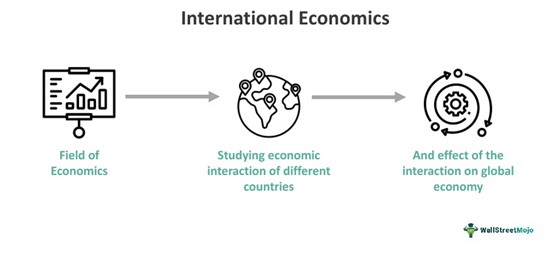International economics (as a multidimensional field) not only gives us priceless information about the underlying complex economic interrelations of states but also proves the incredible usefulness of this discipline for our national economies. This blog’s ultimate goal is to thoroughly explore the delicate balance of IC and SI and its significance as the leading force behind the global arena.
We expect to achieve a complete illustration of the corporate sector that will help in understanding different dynamics and their effects on international economic relations by drawing attention to the main themes lying on the grounds of trade, finance, development, and policy.
1.International Trade Theory:
International Trade Theory is a branch of economics that deals with the intricate dynamics of global trading between nations, the motives behind trade expansion, and the following economic consequences. Trade theory can be based on several perspectives. The classical schools of thought, such as Adam Smith and David Ricardo, cast light on the benefits of specialty and exchange that stem from productivity divergence.
Modern explanations, like Heckscher-Ohlin’s theory, show how the different quantities of the factors of production (workers, capital) in distinct countries can bring about similar trade patterns. The above approach, along with others emphasizing dynamic efficiencies, spatial linkages enhancing scale economy, and market imperfections offers valuable tools for realizing the benefits and challenges of international trade and seeking appropriate policy solutions.
2.International Monetary Theory
In line with this, international monetary theory is a sub-discipline of economics where all the effects of exchange rates, balance of payments, and international finances on the country’s and world economies are studied. Here are some core concepts: Here are some core concepts:
Exchange Rates: People can transfer money, buy and sell goods, invest, and get expensive services. The theories fill the gap in cognition by explaining how exchange rates are formed (e.g., by market forces or authorities interventions), the kind of regimes (floating or fixed or pegged), and the consequences of exchange rate fluctuations for trade and investment.
Balance of Payments: The inscription of all financial transactions for a country with the outside world that covers merchandise and services trade, capital flows, and means of deposits. This line of thought in the field of international monetary theory is concerned with the issue of balancing payment accounts in a sustainable manner as well as the repercussions of the surplus or deficit accounts.
International Capital Flows: Investment or speculation of capital across borders occurs when money moves from one country to the next for that particular reason. This theory highlights the actions that push the international movements of capital (e.g., interest rate differentials, risk perception) to the economies of the exchange rate and the financial instability.
The International Monetary System: The international system of exchange rates, institutions, and agreements that determine how one country’s credit to another is based on the strength of its economy. This incorporates the earlier systems like the Gold Standard and Bretton Woods, which are dynamic in nature, and the more recent, which is based on flexibility like currently.
Monetary Policy Coordination: While there are worries about the collaboration (or lack thereof) among countries through their monetary policies, emphasizing how the decisions of one big bank may affect those of other banks is another issue.
3.Globalization and Economic Development
The world economy has gone through a metamorphosis, and as a result, it has become closely linked and well-integrated into all parts of the globe. This part of the essay discusses globalization’s economic implications, such as its impact on economic development, inequality in income, poverty reduction, and social welfare. We perform the impact analysis of trade openness, foreign direct investment, technology transfer, and international migration. We conclude by identifying the conflicts and possibilities emerging and developing world markets face.
4.Current Issues and Debates:
Finally, we examine current issues and debates in international economics, such as trade tensions, protectionism, global imbalances, climate change, and digitalization. By analyzing recent developments and ongoing challenges in the global economy, we aim to provide insights into emerging trends and potential areas for policy intervention and international cooperation.
Conclusion :
In essence, international economics provides a valuable toolkit that allows us to grasp the intricacies and interconnections of the global economy and the many challenges that come with pursuing economic development and growth in today’s world. Through the revision of main ideas, trade, finance, development, and macroeconomic policy theories, we obtain critical knowledge that allows us to understand the factors behind international economic affairs and, hence, opportunities and dangers of modern nations in the new era of global interdependence.
Since we are moving in an era where globalization takes place with incredible speed and technological advancements, it happens to be a time when a broad perception of international economics is essential for policymakers, business players, and people in general who wish to be successful in the global market.




